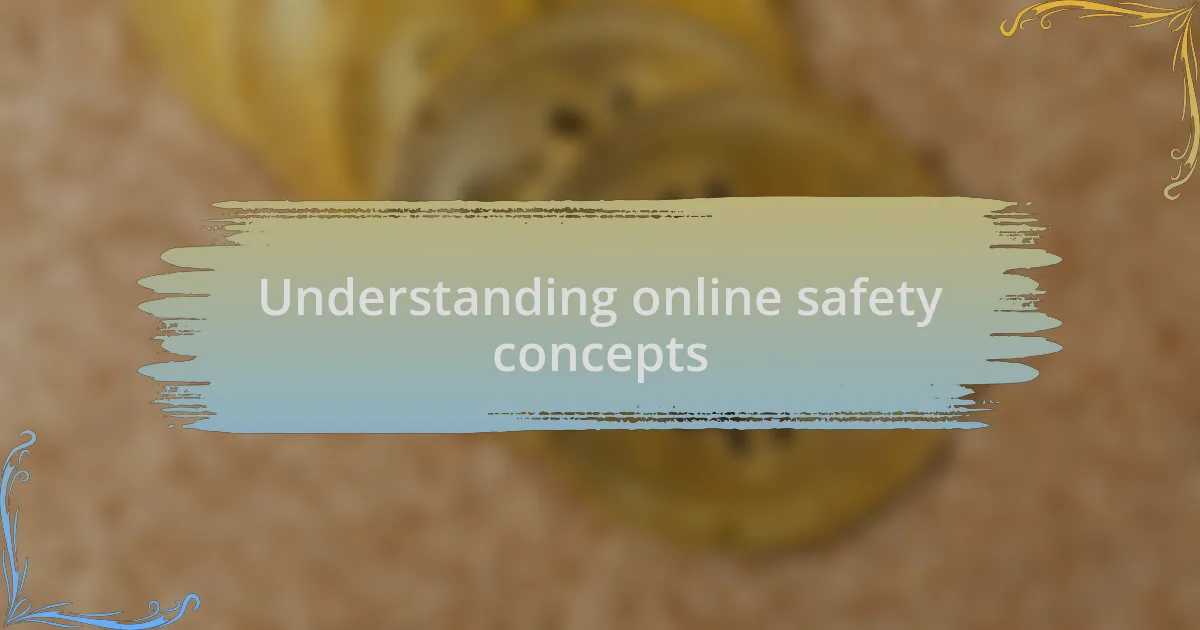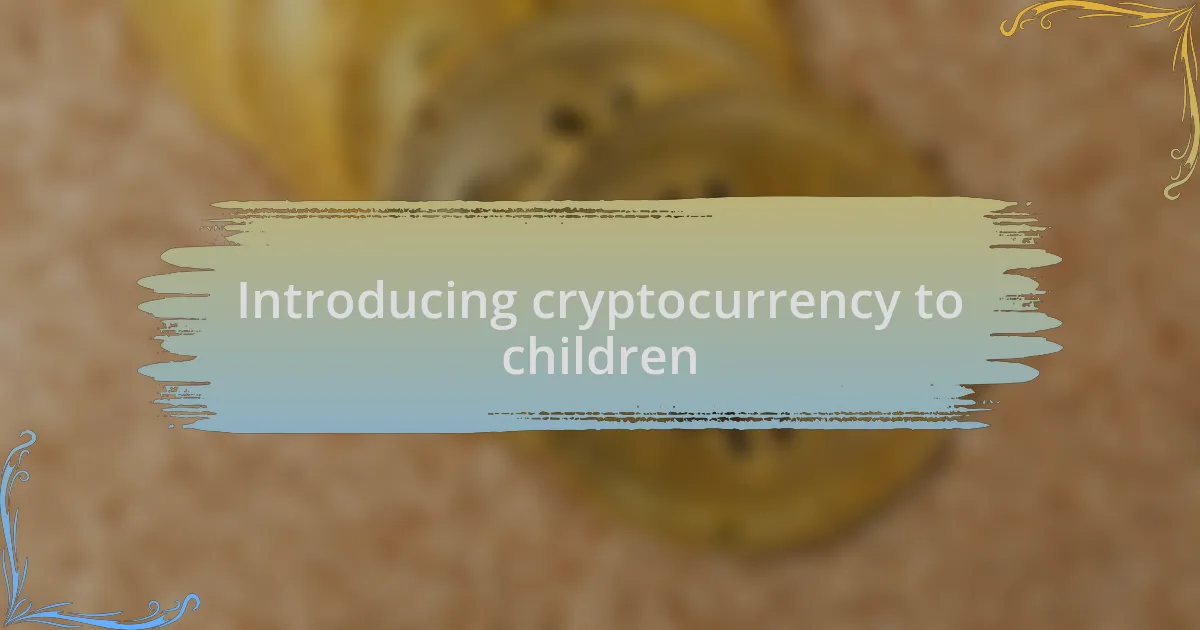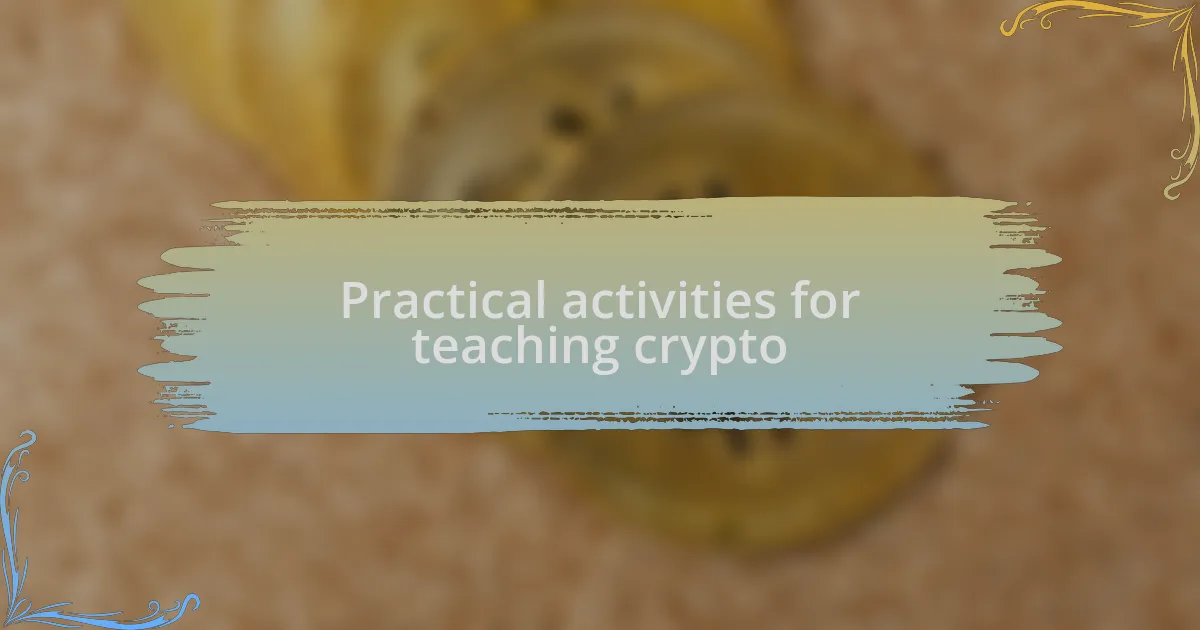Key takeaways:
- Teaching online safety through relatable analogies and real-life scenarios enhances children’s understanding and retention of concepts like privacy and digital footprints.
- Engaging children in discussions about cryptocurrency using familiar concepts, such as video game currencies, sparks their curiosity and encourages critical thinking about finances.
- Implementing practical activities, like mock crypto wallets and bartering games, makes learning about cryptocurrency interactive and relevant to their everyday lives.
- Fostering open communication and involving children in setting online safety guidelines builds trust and encourages responsible online behavior.

Understanding online safety concepts
When it comes to understanding online safety concepts, I’ve found that breaking them down into everyday terms makes a huge difference. For instance, I explain the idea of privacy by asking my kids how they would feel if their room was open to strangers. This analogy really resonates with them and helps them grasp the importance of keeping personal information secure.
Another crucial concept I teach is recognizing reliable sources. One day, my youngest excitedly showed me a video claiming a new cryptocurrency was guaranteed to make him rich. Instead of dismissing it, we sat down together and researched the channel and its claims. This not only taught him skepticism but also sparked a great discussion about the nature of online information, making it a memorable learning moment.
I have also learned through experience that it’s important to discuss the implications of their digital footprint. I ask my kids to consider what could happen if they shared something online that they later regretted. By reflecting on real-life stories of individuals facing consequences for sharing inappropriate content, they begin to appreciate the permanence of their online actions. This conversation often leads to deep discussions about the choices we make and their lasting impacts.

Introducing cryptocurrency to children
To introduce cryptocurrency to children, I usually start by relating it to something they’re already familiar with—like their favorite video game currencies. When my son first discovered that he could earn ‘coins’ by completing levels, I explained that cryptocurrency works similarly but on a much larger scale. It’s exciting for them to see how something intangible can hold value, sparking curiosity and understanding.
Recently, during dinner, I casually mentioned Bitcoin and watched my daughter’s eyes widen as she asked, “But how can something that you can’t even touch be worth money?” That was a golden moment. I took the opportunity to explain blockchain technology in simple terms, comparing it to a digital ledger, so they could grasp how transactions work. These conversations not only demystify concepts but also empower them to view cryptocurrency as an evolving part of our economy.
I’ve found that it helps to engage their imaginations by asking, “What would you buy if you had a million dollars in cryptocurrency?” This question leads to lively discussions about values and the importance of responsible spending. Teaching them about cryptocurrency not only sparks their interest in finance but also gives them a platform to practice critical thinking skills as they consider the implications of using digital currencies in the future.

Practical activities for teaching crypto
One fun way I teach my kids about cryptocurrency is by creating a simple barter system at home. I present them with “crypto coins” made out of cardboard and set up a game where they can trade these coins for privileges like choosing a family movie or the next game night snack. It’s fascinating to see their faces light up when they realize that each decision has value, similar to how transactions work in the real world of digital currency.
Another engaging activity involves exploring cryptocurrency news together. I often find a kid-friendly article or video about Bitcoin and discuss it over our weekend breakfast. This not only keeps them informed but also invites their opinions. “What do you think will happen if Bitcoin becomes widely accepted in stores?” I love hearing their predictions, which makes them feel involved in shaping their understanding of the evolving financial landscape.
I also encourage them to set up a mock “crypto wallet” using apps designed for kids. When my daughter created her account, her excitement was palpable. I guided her through the process, explaining the functions of sending and receiving “crypto” and the importance of security, such as creating strong passwords. This hands-on experience helps them appreciate the responsibility that comes with digital currencies and preparation for their financial futures.
Monitoring kids’ online behavior
When it comes to monitoring kids’ online behavior, I always prioritize open communication. I make it a point to have regular discussions about their online activities, asking questions like, “What did you discover today on the internet?” This not only helps me stay informed but also allows them to share their experiences freely, fostering a sense of trust.
I’ve found that using parental control tools can be quite effective in our household. For instance, I set up filters on their devices, which allows me to limit access to inappropriate content without making them feel overly restricted. Seeing them use their devices comfortably while knowing they’re protected gives me peace of mind, and it reassures them that they can explore the online world safely.
Additionally, I encourage my kids to participate in setting up their own online safety guidelines. Recently, we sat down together to discuss what types of sites they feel comfortable visiting. I asked, “What do you think makes a website safe or unsafe?” Their insights often surprise me, revealing their understanding of digital boundaries while allowing me to guide them in reinforcing those principles.

Encouraging responsible online decisions
Encouraging my kids to make responsible online decisions is a journey we’ve embarked on together. One day, while browsing, my daughter stumbled upon a pop-up ad that caught her attention. Instead of dismissing it, I turned that moment into a learning opportunity. I asked her, “What do you think this ad is trying to do?” This sparked a conversation about advertising tactics and how not everything we see online is safe or genuine. It was rewarding to see her begin to think critically about what she encounters online.
I also find that role-playing scenarios works wonders in reinforcing responsible behavior. Once, I pretended to be a friend who asked for personal information online. My son immediately called me out, saying, “That’s not safe!” His confident response made me appreciate that he is beginning to apply what we’ve discussed in real-life situations. Such moments not only affirm their understanding but also build their confidence in navigating online spaces independently.
To foster a sense of accountability, I encourage my kids to reflect on their choices after online sessions. We often ask, “Did anything you saw today make you feel uncomfortable?” This approach allows them to articulate their feelings and helps me understand their online experiences better. It’s heartening to see them develop a sense of ownership over their digital footprints, knowing they can always come to me with any concerns.